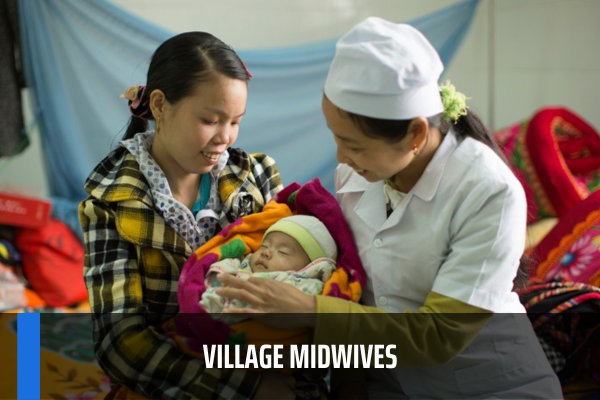What are the tasks for Village midwives in terms of healthcare? What are the standards for Village midwives in Vietnam?
What are the tasks for Village midwives in terms of healthcare in Vietnam?
According to the regulations in Clause 1, Article 5 of Circular 27/2023/TT-BYT, the tasks for Village midwives in terms of healthcare include the following:
(1) Participating in the healthcare of mothers, children, and medical activities in villages and hamlets, including:
- Disseminating, guiding, and counseling on reproductive health for women of childbearing age, promoting women's hygiene, antenatal care, proper nutrition, and eliminating harmful practices for the health of mothers and children; encouraging pregnant women to register for prenatal care, prenatal check-ups, tetanus vaccination, seeking medical care for childbirth, and ensuring children receive complete vaccinations according to their age;
- Disseminating, counseling on signs of danger during pregnancy and postpartum, signs that require immediate medical attention; counseling on prenatal screening; promoting the benefits of breastfeeding, guiding breastfeeding techniques and maintaining a breast milk supply, providing proper supplementary feeding, and preventing malnutrition in children under 16 years old;
- Participating in the implementation of healthcare programs and projects in villages and hamlets;
- Participating in training courses, workshops, and professional development to improve skills and knowledge;
- Instructing the use of tools for monitoring and caring for the health of mothers and children in both paper and electronic formats;
- Participating in regular meetings with the commune health station;
- Timely and fully reporting as instructed by the commune health station.
(2) Participating in medical examination and treatment in villages and hamlets as detailed in Clause 2, Article 5 of Circular 27/2023/TT-BYT.

What are the tasks for Village midwives in terms of healthcare? What are the standards for Village midwives in Vietnam?
What are the standards for Village midwives in Vietnam?
According to Article 2 of Circular 27/2023/TT-BYT, the standards for Village midwives are as follows:
(1) Professional qualifications and training: Village midwives must meet one of the following criteria:
- Completion of a certified training program in the prescribed professional and vocational content, as follows:
- For Village midwives: the professional and vocational training content specified in Appendix 04 of this Circular, with a minimum training period of six (06) months.
- For Village health workers concurrently performing the role of Village midwives: the professional and vocational training content specified in Appendix 05 issued with this Circular, with a minimum training period of three (03) months.
- Possessing professional qualifications in medicine (doctor, physician, nurse, midwife) from intermediate level or higher.
(2) Voluntarily participating as a Village health worker or Village midwife.
(3) Having sufficient health to perform the prescribed tasks.
What is the content of professional training for Village midwives in Vietnam?
Pursuant to Appendix 04 issued with Circular 27/2023/TT-BYT regulating the content of professional training for Village midwives includes the following:
No | Professional training |
1 | General anatomy - physiology of female reproductive system |
2 | Roles and responsibilities of Village midwives in maternal and child healthcare. |
3 | Infection control in providing reproductive healthcare services in the community |
4 | Essential drugs and their usage |
5 | Prevention and mitigation of climate change and environmental pollution |
6 | Identification of certain whole-body signs and dangerous signs |
7 | First aid and initial emergency response |
8 | Initial management of common symptoms and diseases |
9 | Care during pregnancy |
Counseling for couples before pregnancy | |
Characteristics of the pregnancy process | |
Prenatal examination | |
Abnormal signs during pregnancy | |
Clinical practice at the health facility on pregnancy care | |
10 | Delivery care |
Signs of labor - monitoring labor | |
Preparation before assisting in delivery | |
Normal delivery using clean delivery kit | |
Management of deliveries in the community | |
Initial management of bleeding during and immediately after delivery | |
Checking the placenta | |
Clinical practice at the health facility on delivery care | |
11 | Postpartum maternal and newborn care in the first 6 weeks at home |
Postpartum maternal care in the first 6 weeks at home | |
Bathing the newborn, skin care, cord care | |
Kangaroo care for low birth weight infants | |
Breastfeeding and management of infant spitting up | |
Clinical practice at the health facility on postpartum maternal and newborn care at home | |
12 | Communication on prevention of malnutrition, epidemic diseases, counseling in maternal and child healthcare in the community |
13 | Child healthcare |
14 | Nutrition for children and feeding infants |
15 | Expanded immunization |
16 | Support for transporting mothers and newborns to safe healthcare facilities |
17 | Application of information technology, health statistics, and reporting |
18 | Instruction on using monitoring tools for maternal and child healthcare in both paper and electronic versions |
19 | Management and community healthcare (Application of traditional medicine and functional recovery, nutrition in care. Detection and initial management of locally prevalent diseases). |
20 | Community-based practical training |
LawNet